Life Span: Period from birth to natural death of an organism.
- It doesn’t depend on size. eg. sizes of crow and parrot are similar but life span show wide difference, also mango tree has much shorter life span than Peepal tree.
- No individual is immortal except single celled.

Reproduction: Biological process in which organism gives rise to young ones similar to itself.
- It enables continuity of species, generation after generation.
- Its of 2 types - asexual and sexual reproduction.
Asexual Reproduction:
- Offsprings are produced by single parent with or without involvement of gamete formation.
- Offsprings are identical and exact copies of their parent.
- Clone: Morphologically and genetically similar individuals.
- Common among single celled, plants and animals with simple organisation.

Cell division: Parent cell divides into 2 and give rise to new individuals.
eg. Protists and Monerans
2. Binary fission: Cell divides into 2 halves and grow into an adult.
eg. Amoeba, Paramecium.
3. Budding: Unequal division, bud remains attached to parent cell initially and then gets separated and mature to new organism. eg. Yeast and Hydra.

4. Multiple fission:
- Encystation: Under unfavourable condition Amoeba withdraws its pseudopodia and secretes 3 layered hard covering (cyst) around itself.
- Sporulation: Under unfavourable condition, it divides by multiple fission and produce minute spores (Pseudopodiospores), cyst wall bursts out and spores are liberated.
5. Special reproductive structures: in algae and members of kingdom fungi
(a) Zoospores: eg. Chlamydomonas
(b) Conidia: eg. Penicillium
(c) Buds: eg. Hydra
(d) Gemmules: eg. Sponges
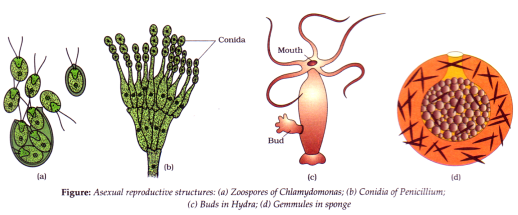
6. Vegetative Propagation: in plants.
- Vegetative Propagules: runner, sucker, rhizome, tuber, offset, bulb give rise to new offspring.
- eg. rhizome of ginger, offset of hyacinth, bulbil of Agave.
7. Fragmentation: body breaks into fragment which give rise to new offspring. eg. Hydra.
8. From nodes: nodes come in contact with damp soil and produce roots and new plants, for commercial purpose also. eg. rhizome in banana, ginger and buds (eyes) in potato.
9. From leaf: adventitious buds arise from notches at leaf margin. eg. Bryophyllum.
- Simple organisms like algae and fungi shift to sexual reproduction before onset of adverse condition.
- Higher plants exhibit both sexual and asexual (vegetative) mode of reproduction while most of the animals exhibit sexual reproduction.
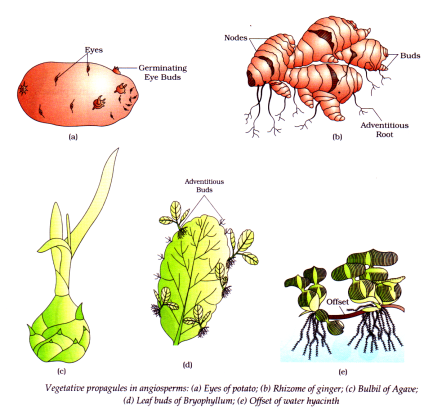
Terror of Bengal: Scourge of water bodies.
- Water hyacinth: Most invasive weed growing in standing water.
- It drains oxygen from water and lead to death of fishes.
- It spreads over the water body in short period of time so its difficult to get rid of them.
- It was introduced to India because of beautiful flowers and leaf shape.
Sexual Reproduction:
Involve fusion of male and female gamete.
- 2 parents involved.
- offspring aren’t indentical to parents.
- fusion of male and female gametes result in zygote.
1. Juvenile phase: Period of growth, also called vegetative phase (in plants)
2. Reproductive phase: at end of juvenile phase, followed by morphological and physiological changes.
3. Senescence phase: end of reproductive phase, slowing of metabolism, lead to death.
- Annual and biennial plants show clear cut vegetative, reproductive and senescent phases but perennial species don’t due to inter-flowering period.
- Bamboo: flower once in 50-100 years, produce fruits and die. It is monocarpic.
- Strobilanthus kunthiana (neelakuranji): Flower once in 12 years, last in Sep-Oct 2018, found in hilly areas of Kerala, Karnataka and Tamil Nadu forming blue stretches.
- Birds living in nature lay eggs seasonally whereas in captivity lay eggs throughout the year (commercial exploitation).
- Oestrous cycle: in non-primates like cow, sheep, rat, deer, dog, tiger.
- Menstrual cycle: in primates like monkeys, apes, human.
- Seasonal breeders: Reproductively active during favourable season in reproductive phase.
- Continuous breeders: Reproductively active throughout reproductive phase.
- Interaction between hormones and environment regulate reproductive process and expression.
Events in Sexual Reproduction:
1. Pre-fertilisation: Gametogenesis + gamete transfer.
(a) Gametogenesis: formation of male and female gametes.
- Gametes are haploid cells.
- Homogametes: 2 gametes are similar in appearance. eg. Algae also called isogametes.
- Heterogametes: 2 gametes are morphologically distinct, in majority of organism, male gamete- antherozoidlsperm and female gamete- egg/ovum.

- Bisexual: Both male and female flowers in same plant, also called monoecious/homothallic. eg. cucurbits, coconut, sponges, earthworm, tapeworm, leech, chara, sweet potato.
- Unisexual: male and female flowers on different plants, also called dioecious/heterothallic. eg. papaya, datepalm, cockroach.
- Staminate: Unisexual male flower. i.e. bearing stamens.
- Pistillate: Unisexual female flower. i.e. bearing pistils.
- Haploid plant produces gamete by mitotic division.
- eg. Monera, Fungi, Algae, Bryophyte
- Diploid body produce haploid gamete by meiosis.
- eg. Pteridophyte, Gymnosperms, Angiosperms
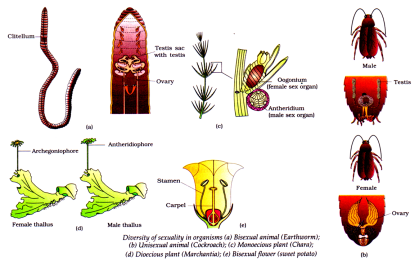
They have specialized cells-meiocytes (gamete mother cell) and only one set of chromosomes get incorporated into each gamete.
They have specialized cells-meiocytes (gamete mother cell) and only one set of chromosomes get incorporated into each gamete.
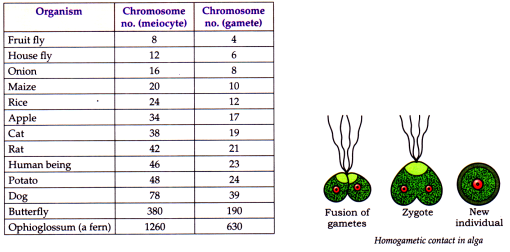
- In bisexual plants, its easier as anther and stigma are located close to each other e.g. peas.
- In cross pollinating or unisexual plants, pollination facilitates transfer of pollen grains, which germinate on stigma and pollen tubes carry male gamete to ovule.
2. Fertilisation: Fusion of gametes (syngamy) results in diploid zygote.
- Parthenogenesis: Female gamete undergoes development to form new organisms without fertilisation.
eg. rotifers, honeybee, some lizards, turkey.
(a). External fertilisation: Syngamy occurs in external medium. i.e. outside the body of organism.
- Release large no. of gametes in surrounding medium to enhance chances of fertilisation.
- These offspring are vulnerable to predator.
- eg. most aquatic organism, majority of algae and fish and amphibians, bony fish, frogs.
(b). Internal fertilisation: Syngamy occurs inside body of organism.
- egg is formed inside female where they fuse with male gamete (motile)
- no. of sperms are large but eggs produced are less.
- In seed plants, non-motile male gamete are carried by pollen tubes.
- eg. terrestrial organisms-fungi, higher animals like reptiles, birds, mammals, majority of plants-bryophytes, gymnosperms and angiosperms.
3.Post-Fertilisation:
(a) Zygote: Occurs in all sexually reproducing organisms, single-celled.
- Its formed in external medium in external fertilisation whereas inside the body in internal medium.
- Its a vital link that ensures continuity of species between organisms of one generation and next.
- In haplontic life cycle, zygote divides by meiosis to form haploid spores.
- In fungi and algae it develops a thick wall resistant to dessication and damage. It undergoes period of rest before germination.
(b) Embryogenesis: Development of embryo from zygote.
- Zygote undergoes cell division (increase in no. of cells in embryo) and cell differentiation (cells undergo modification to form specialised tissues and organs).
- Oviparous: fertilised eggs are covered by hard calcareous shell and laid in safe place, after incubation young ones hatch out. eg. reptiles and birds.
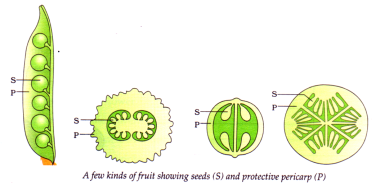
- Viviparous: Zygote develops inside female body and after certain time young ones are delivered out female body. eg. majority of mammals, human being.
- Because of proper embryonic care and protection, chances of survival are more in viviparous.
- In flowering plants, zygote is formed inside ovule. After fertilisation, sepals, petals and stamen of wither and fall off. Pistil remain attached to plant.
- Zygote develops to embryo and ovules into seed .
- Ovary develops to fruit which develops thick wall pericarp (protective). After dispersal, seed germinate under favourable condition to produce new plants.
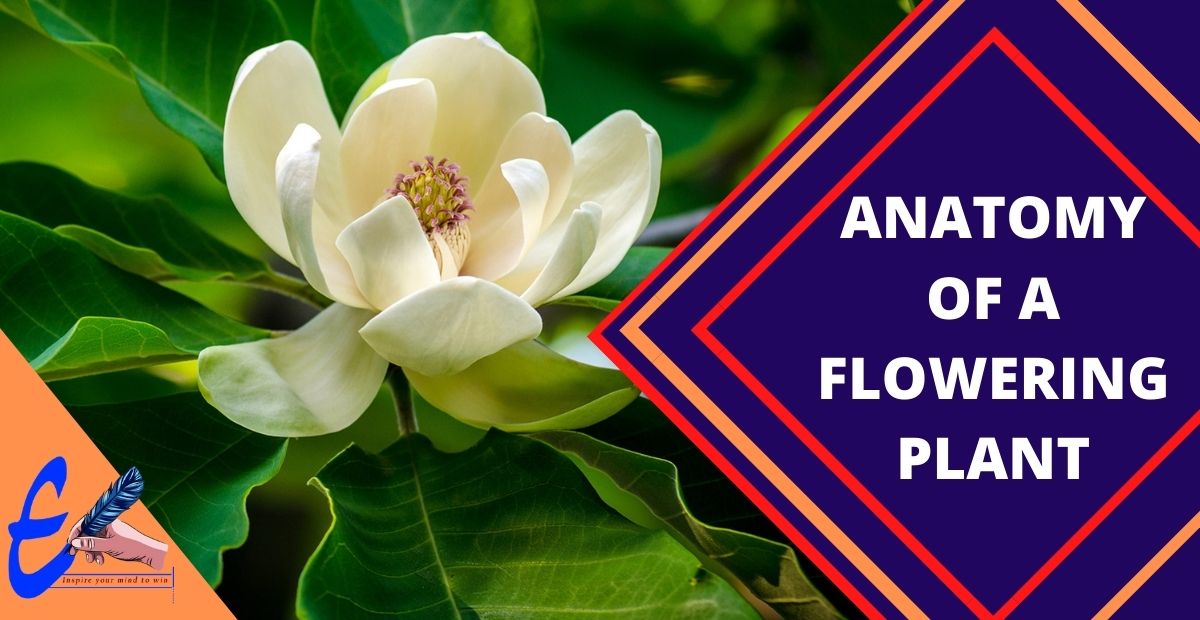
… [Trackback]
[…] Read More Information here on that Topic: eklabhyaclasses.com/blog/reproduction-in-organisms/ […]
… [Trackback]
[…] Here you can find 9977 more Information on that Topic: eklabhyaclasses.com/blog/reproduction-in-organisms/ […]
… [Trackback]
[…] Read More on to that Topic: eklabhyaclasses.com/blog/reproduction-in-organisms/ […]